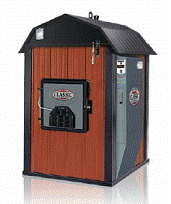Biomass Heating and Cooling Technologies
Biomass is a term that covers different types of organic material that can be processed and burned to produce energy, including trees; construction, wood, and agricultural residues (such as corn husks, rice hulls, peanut shells, grass clippings, and leaves); crops; sewage sludge; and manure.
Thermal applications use two main forms of biomass materials: woody biomass and gas or liquid biofuels. This Web page focuses primarily on woody biomass.
Biomass contains stored energy. Plants absorb energy from the sun and convert this solar energy into chemical energy during the process of photosynthesis. This energy is released as heat when the plants or other organic materials are burned.
Biomass is considered a renewable resource. Trees and fuel crops can be replaced on the time scale of human lifetimes or as short as annually, and agricultural residues, sewage sludge, and manure will continue to be generated as part of regular farm and manufacturing activities. Biomass, however, is not necessarily a carbon-neutral resource. A determination of carbon neutrality requires an assessment of the particular conditions under which a type of biomass (e.g., feedstock) is grown and consumed.
Biomass can be used to generate electricity, and it can also be converted into liquid fuels for motor vehicles, but this page focuses on thermal energy applications. Visit EPA’s Clean Energy website to learn more about other uses of biomass and the environmental benefits and impacts of biomass energy.
Woody Biomass

For thousands of years, people have created heat by burning wood and other organic materials in their fireplaces, wood stoves, and campsites. Today’s biomass space heating technology has evolved to include highly efficient wood stoves, pellet stoves, fireplace inserts, and hydronic heaters, to name just a few options. In addition, biomass fuels have evolved over time from biomass solids to now include highly processed wood pellets that burn at extremely high temperatures, which makes the heating system more efficient and cleaner-burning than traditional fireplaces or wood stoves.
In addition to residential stoves, pellet and wood chip boilers can be used for larger commercial or industrial heating systems. For example, pilot programs in New York and Vermont are investigating biomass heating systems for schools. Pulp and paper mills have abundant sources of woody biomass, so they frequently burn waste timber to produce both heat and electric power.
- If you are interested in using woody biomass at home, visit EPA’s Burn Wise website to learn more about the importance of burning the right wood, the right way, in the right wood-burning appliance to protect your home, health, and the air we breathe.
